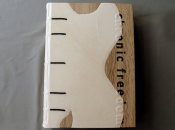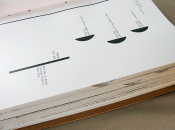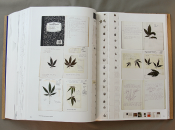2010 (prod. 2010 – 2014), ed. of 25. Over 1,000 pages (varying depending upon bullet-vault depth), 19 ½ x 13 ½”, offset-printed in color and black and white, including micro-printing. Hand sewn to ⅛” polyethylene drip lines for cords and tight-back covered and partially encased in calf skin attached to Southern Humboldt County, California-grown and -milled white oak panels. Titles are water-jet-cut high-carbon steel letters. Fired bullet slugs corresponding in caliber to those which killed the three young men whose individual sections begin the book are set into niches carved within blocks of blank pages preceding each section. Inserts tipped in the book include turkey oven bags and grocery bags used to store and process marijuana buds and sections of a variety of soil and soil supplement bags as well as promotional CD stickers and a card-stock audio cassette caseliner. Copies are offered to approved collectors only.
chronic freedom contains four parts beginning with an introductory essay, “Against Dialogue: for speaking only to ourselves,” followed by three sections, each on the lives and deaths of three young men, all children of the hippie generation.
The third part is comprised of several chapters of original writings and interviews and reproduced newspaper accounts on the hip hop music and scene made by peers of the dead men. These pages speak of the way hip hop as a transformative and transgressive music has, since the late 1990s, been used by young SoHum men in describing their own lives—the chronic freedom of their own stories as outlaws within a broader outlaw past.
The fourth and last part, “Hippies & Weed: Southern Humboldt County 1968 – 2010,” reproduces a survey of local and national media—including entire books, community newsletters, private journals and play scripts, often printed in micro-tiles that require magnification, sometimes accompanied by commentary and altered by graphic interventions.
Framing the assembled reproductions and other traces are impressionistic (and other) texts by Scott Holmquist that run alongside original vignettes outlining a history of Southern Humboldt hippie life by Douglas Fir. Interviews, by Holmquist, of adult children of the 1960s and ’70s back-to-the-land settlers and with settlers themselves about raising children in the hills, among other assorted interviews, make up another large part of this section. All interviews are reproduced verbatim with words struck out by request from interviewees. These barred words remain as blacked-out gaps within the text.


